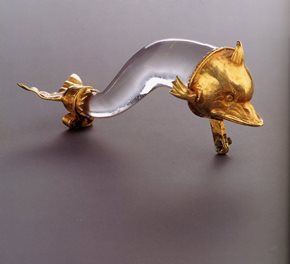
Golden Dolfin fibula,
Sarmatian, 1st century
(1)
The SARMATIANS

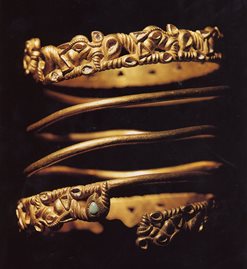
Golden spiral bracelet,
Sarmatian, 1st century
(2)

Golden Dolfin fibula,
|
The SARMATIANS
|

Golden spiral bracelet,
|
*
*
The SauromatiansFirst mentions from the 6th century b.c.The oldest archaeological remains of the Sauromatic culture are found in Kazakhstan, north of the Aral Sea, Palus Maeotis. They are tombs from the 9th-8th century BC, called Kurgans, located in the valleys of the Don, the Volga and the Urals and in Kazakhstan from the Altai Mountains to the Tarim Basin at the easteren borders of the Chinese province Gansu. The culture changes slowly and is therefore divided into an early, middle and a late Sarmatic period. The Greek historian Herodotus is the first who mentions them in his history book as Sauromatians when he recounts that they fought in 514 together with the Scythians against the Persian king Darius that invaded Scythia. (3). They are pastoralists, traders and metalworkers and inhabit the steppes east of the Scythians, behind the Don from the Sea of Azov to a fifteen days' journey northward to the Urals and Kazakhstan. Behind them, eastwards, lived the Massagetae and the Saka's. Hippocrates wrote a quarter of a century later that Sauromatians were living a piece westward near the Sea of Azov. In Greek literature, they are called a century later Syrmates. Pliny mentions them Aryans. (4) Probably these peoples were related to each other. They spoke the same Iranian-European language which belonged to the Indo-European language group but was colored by Indian influences. Their behavior and culture were similar. M. Ammianus writes about the year 350 on Massagetae who we now call Halani, they are excellent horsemen, and also fight well on foot. They use bows, swords, breastplates, and sagares of brass, they wear golden belts, and turbans on their heads in battle. (5) 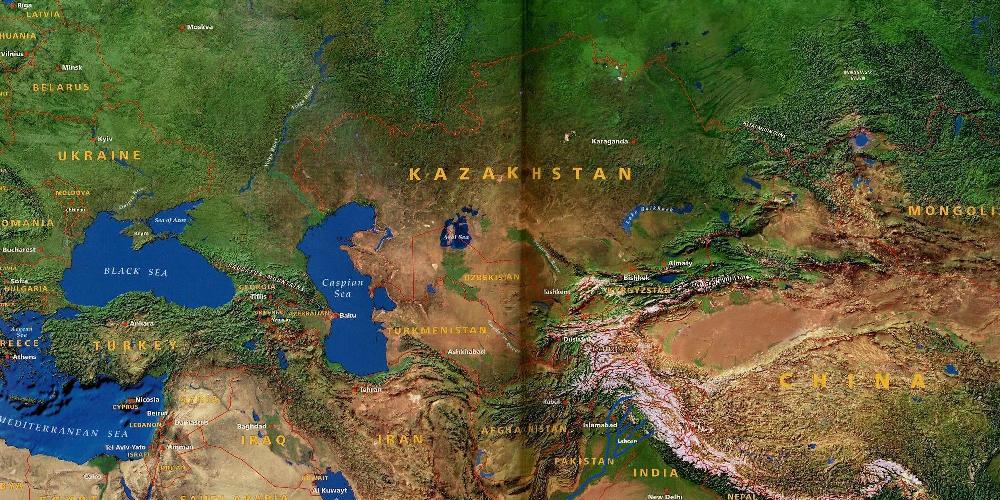
Map of the Middle East and southern Russia The Sarmatians From Kazakhstan to the Ukraine
|
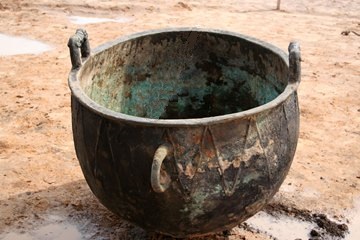
Massive cast bronze cauldron |
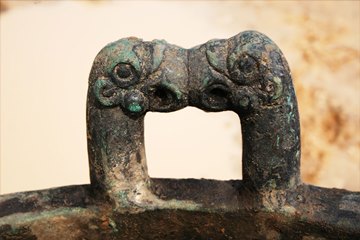
The handgrips in the form of two dragons. |
The material associated with the burial seemed to belong to a woman as it contained what is regarded as representing typically female artefacts and jewellery. However, initial osteological examination of the skeletal morphology revealed the occupant of the burial to be male; though DNA-analysis is still to be carried out. (5a)
The symbol of the legless dragon with an pearl in his beard or mouth is already seen in the Chinese Hongshan time, about 7000 - 5000 b.p. In Roman times this was the Insignis of the Taifali, a probable Sarmatian tribe living in the Hungarian plane, during their service in the Roman legions.
The Sarmatians are gradually drawn to the West, most likely under pressure from more easterly peoples. Five centuries before our era they were still in their areas of Kazakhstan. From the 4th century when in Greek and Latin writings they are called Sarmatians, the western types of graves in the Ukraine, between Djnepr and Volga, show obvious changes compared with the older eastern ones. Possibly this is due to the incorporation of new strains. In this Sarmatian graves of that time are found beautiful jewels, often decorated with animal figures. (6)
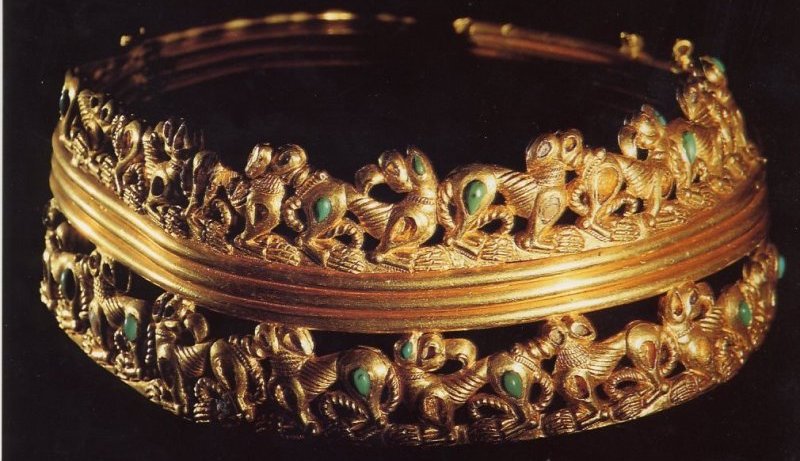
Golden necklace, Sarmatian, 1st century (7)
For all we know the Sarmatians had a normal European appearance, except the easternmost who owing to intermarriage exhibited Mongolian features. Almost all are large, between 180 and 190 cm. their hair tending to blond. Most people found them handsome but very frightening. Tacitus only find them horrible.
The ancient Roman writers very often had no clear picture of the history of the barbarian peoples. Siculus thought that the Sarmatians came from Medes, also heard their voice. (8)
With the Scythians who lived west of them and who are of probably Northern European origin they share many characteristics. Probably they have a common origin. They spoke a slightly different language. The Scythians were also very artistic and beautiful jewels are found in their graves.
A Chinese scolar thinks the distribution of haplogroup N, that exist mainly in the Yi people living in the mountains of rural regions in China, came from Sauromatians wherein it should have been relatively high, probably higher than 61.5%. (9)
The Greek writer Herodotus heard about the origin of the Sarmatians a story which is told him as being true that should not be missing here.
Once the Greeks had fought against the Amazons, the Breastless, who are mentioned by the Scythians as the Men killers, and they had won the victory at the River Thermadon. Hereafter they sailed back with the Amazons that had survived and they had captured as prisoners in their vessels.
But at sea these indomitable women killed their guards. They knew however nothing about ships and could not stir, sail or handle oars, and they were at the mercy of the wind and the waves. They arrived in the Crimea at the Sea of Azov where the Scythians live. There they invaded the land and soon they came to a horse breeding which they plundered, and on horseback they robbed the land of the Scythians.
When these discovered that their opponents were women, they sent to them young men who had the command not to kill them but to built a camp in their vicinity and to do as they did and go hunting and poaching. The purpose of this plan was that the Scythians wanted children from them. After a time they became friends and joined the camps. This togetherness proved to be very fruitful and from them originated the people of the Sarmatians.
The women refused, however, to follow their husbands in the Scythian land where women devote themselves to women's work without ever leaving their cars. So they took their men and children to the other side of the Don where they settled. The female offspring took the habits of their mothers and continued to love hunt and fight. (10)
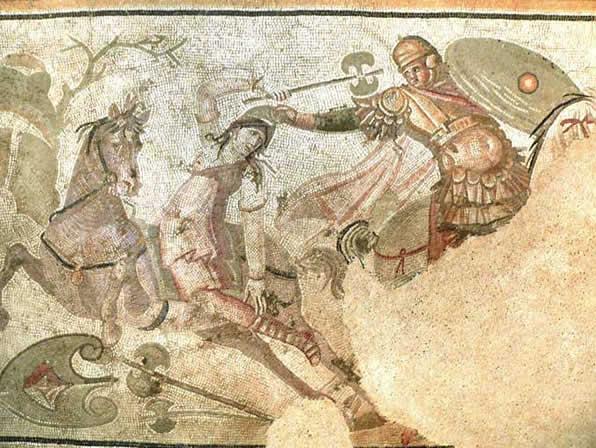
Fragment of a mosaic floor with Amazon. (11)
Herodotus mentions a people Mares (Μαρεσ), that in the years 518-517 BC was part of the 19th satrapy of the Persian Empire under Darius. They inhabited the coasts between Colchis and Thermodon. The region where the Amazons lived (12)
The great expansion began at the time of Alexander the Great between 334 and 325 b.c. The Sarmatians left at that time the area between the Dnjepr and the Volga and moved to the southwest. The first characteristic Sarmatian Kurgans appear in late 4th century between Don and Donets. On the left bank of the Dnjepr, there are many found dating from the 3rd and 2nd century. From that time date also fortified settlements build by the Scythians, most likely in response to the Sarmatian expansion.
In the 2nd century b.c. the Sarmatians they were frequently involved in stirrings on the Crimea and the Bosporus. Polybes mentions in connection with this a peace treaty in 179 BC of a Sarmatian king Gtalos, who had made a covenant with the city Cherones, at current Sebastopol, against the Scythians of Crimea.
From this period dates the possible legendary story of the Sarmatian queen Amage, wife of King Medosakkos, a hedonistic drunkard, for whom she arranged the legal, diplomatic and military affairs. The inhabitants of Chersonese had invoked her protection against the Scythians of Crimea that did difficult. At the head of a cavalry of 120 men, each rider with three horses, they bridged the distance of 1200 stadia, about 212 kilometers, to the palace of the Scythian king in one day. After taking the palace the guards were slain to the last man, then the entire royal family with their friends and councilors were massacred, all except a son that they left alive and placed on the throne, after ordering him to behave henceforth properly.
In the 2nd century v.c. the Sarmatians completed the conquest of the ancient Scythia and took possession of the steppes of the Ukraine west of the Djnepr. The vanguard crossed the river by the end of the 3rd century. We know that because from that times dates a Sarmatian tomb at Ouchalka in Nikopol. As tribal names we read Saudorates and SaÔens listed under their king SaÔtapharnes. According to Strabo the steppes west of the Dnjepr were already in the hands of the Sarmatian Iazyges.
In this time the Scythians disappear from view and it has not yet been clarified whether genocide has taken place or that they, at least partially, have been absorbed into the Sarmatians, The Sarmatian culture changed then and shows a clear Scythian influence so that the latter, in any case at least partially, has occurred, but I fear the worst.
During that whole time the peoples north of the Black Sea, from Danube to Don, are usually called Scythians, even by Ammianus Marcellinus who lived in the 5th century AD. (12a)
After they had expelled the Dacians out of the area between Danube and Tisza the Emperor Tiberius, 42 - 37 b.c. acknowledged by a treaty Sarmatia, their country, as a vassal state of Rome. Rome granted their independence and the Iazyges should protect the Roman frontier against attacks from outside and would deliver cavalry troops as Auxilia, for Roman legions. (14). In this time these Sarmatians are increasingly being called Iazyges
Gaius Octavian, the future Emperor Augustus, conquered from 12 to 7 b.c. an area west of the Danube. This region became under Emperor Claudius (41-54) the province Pannonia and is now the western part of Hungary. The Sarmatians penetrated many times the left side of the Danube. From the beginning of the 1st century Sarmatian raids are reported in the Roman area on the other riverside. So invaded Sarmatians and Dacians in the years 6 and 9 MoesiŽ and Pannonia, now Bulgaria, and in 18 Macedonia to assist the revolting Thracians. In 21 and 26 the Iazyges provided the Thracian kings with a cavalry.
Sarmatians are are well-known and much sought cavalrymen, of whom the chiefs choose opposite parties and so accept gifts from two rival parties. In 35 AD. fought a group as mercenaries with Pharasmanes, king of the Hiberians a people south of the Caucasus against the Armenians, while another group Sarmatians fought together with the Parthians for the Armenians. (13)
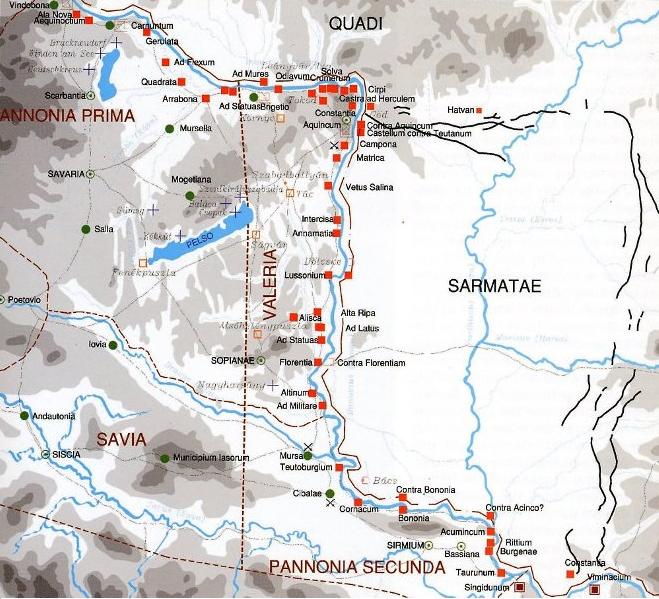
The Sarmatians in the area in the Danube basin
The Limes is indicated by the black lines that indicate ramparts.
The boundary ran from Aquincum, nowadays Budapest, to just east of Singidunum, now Belgrade.
Vindobonum (top left) is nowadays Vienna.
(15)
In the year 50 the Iazygian cavalry was involved in the internal succession struggle of the Sueves, when they defended Vannius, who was appointed king by the Romans and who had made the country very prosperous, against his cousins Vangio and Sido, who with the help from neighboring Germanic tribes took over the rule. (16)
During the ongoing unrest Roxolani and Bastarnians also went westward. They invaded Moldova and Wallachia. In these riots were also Marcomanni and Quaden involved.
When the Sarmatians after this in 88 invaded the Empire, they were met by the Roman legion Legio XXXI Rapax, that they completely destroyed and wich commander they killed, at least according to the Roman historian Suetonius. Flavius Josephus however writes that only some Roman border guards were killed but indeed and the envoy Fonteius Agrippa who offered fierce resistance was slain. (17)
The following year Emperor Domitian (81-96), sent Rubrius Gallus to Sarmatia. He reinforced the border surveillance and concluded treaties with the Iazyges and Roxolani on a manner that they could protect themselves adequate especially the Dacians. To celebrate his victory the emperor sacrificed on the Capitol a laurel wreath to Jupiter. (18)
In the years 107 and 117 Iazyges and Roxolani seek to penetrate Pannonia.
In the years 174-175 the battles are so fierce that is spoken of a Sarmatian war. The Iazygs under viceroy Barnadaspos penetrate in Pannonia, belittle the Roman army and collect a big booty. The Roman emperor Marcus Aurelius ended the war in the year 175.
In the peace treaty he arranged a no man's land of 15 kilometers on Sarmatian area between the Empire and The Sarmatians. This is the first known No man's land idea. The Sarmatians let free all prisoners of war 100,000 in number and delivered a cavalry to Rome of 8000 man. Rome on his part Rome is committed to help build a defense wall on the Sarmatian eastern border against the Dacians. They became foederati of Rome. That means that they got an irrevocable lease covenant Foedus with Rome, where they remained completely autonomous.
|
Of the 8000 cavalrymen 5500 of them will form the sixth legion Victrix, which is sent to Britain. They are placed on the northern border of the Roman Empire near on Hadrian's Wall, the barrier against the Picts and Saxons. Later they were again largely withdrawn from Britain. One company, the ala prima Sarmatarum, was placed permanently in England and there came an great Sarmatian colony in Bremetenacum Veteranorum, located at current Ribchester in Lancashire where veterans were given land and they settled with their wives and children. It existed at least till the 4th century. There are Sarmatian tombstones preserved. (18a) Besides archaeological remains also remained their myths and legends. the same as survived with other descendants of Sarmatians in northern France and in present-day North Ossetia-Alania in their stories cycle the Narts. The hero in this tale is Batraz who lives on in the British King Arthur. The legends surrounding Arthur and his knights are peppered with the myths of the Nart cyclus. |
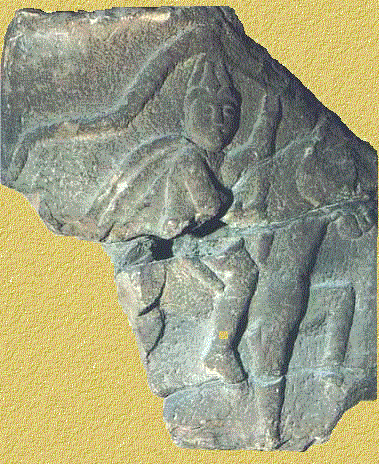
Sarmatian tombstone, with dragon banner,
|
|
* In the Germanic war, 177-180, the Iazygs remained loyal to their covenant with the Romans. Because of their help the conditions became more favorable and the freedoms greater which improved the trade with their relatives the Roxolani in Dacia and Moldova. During the following centuries there are only periodic skirmishes with the Romans. In the year 260 the emperor Gallienus renewed the foederatus relationship with the Roxolani, on the other side of the lower Pannonia. At the time of Emperor Diocletian (284-305) the Sarmatians invade in Pannonia and MoesiŽ. The unrest is so great that there is talk of the Sarmatian war, 289-292. The emperor restores tranquility. Emperor Galerius I, 299-314, is leading several successful expeditions against encroaching Sarmatians and get for this the name of honor Sarmaticus. Emperor Constantine I (306-337), the last absolute ruler of the Roman Empire, is in the year 322 again at war with the newe groups of Sarmatians that came from the cost-lands of the Sea of Azof, Palus Maeotis), led by King Rausimodus. They had come westwards and crossed the Danube. He drives them back and Rausimodus was killed. (19a) In the year 357 the Sarmatians did together with a neighboring nation the Quad incursions in the Roman bank of the Danube in Pannonia and MoesiŽ led by their princes Zizais, Rumo, Zinafer, Usafer and Fragiledus. A contemporary writes about them These barbarians, who are better in raids than in open battle, armed with long spears and wearing armor of linen shirts on which are sewn as scales polished plates of horn. Their horses are usually intentionally cut to prevent them from getting in excitement at the sight of mares and break free or in ambushed become wild by neighing and betray the presence of their riders. In pursuit or fleeing they do huge distances on that quick, well-trained horses, whereby they take still one or two as reserve, keeping them in top condition by changing them regularly and let them in turn recover their breath. (20a) Emperor Constantine joined battle with them and drove them back behind the Danube. They entered into a peace treaty that provides that sons of nobles were delivered as hostages and their prince Zizais became king over the different tribes. In the Hungarian Plain will be built jointly by Romans and Sarmatians a boundary line on the north and east of the Sarmatian country. This consists of ramparts and moats. The line should better protect their area against the Germans in particular the Goths. He ran from where nowadays lies Budapest towards the east, about to Debrezen and thence south to the Iron Gate, way beyond Belgrade. The following year in 358 the servile tribe, the Limigantes came in revolt against the leading tribe, the Argaragantes in an internal Sarmatian war. They expelled their masters and made incursions into Roman territory. By Emperor Constantius they were militarily called to order. They got residences in a secluded area and became under the authority of the king of the free Sarmatians Zizais. The Taifales and Pincenses peoples who lived in that regio were also placed under this Sarmatian king. (20) The warrior nobility, the Argaragantes, 30,000 in number (21) sought refuge in the Roman Empire and received a warm welcome and got settlements for them and their families in different provinces in the heartland of the Empire in Thracia, Macedonia and Northern Italy. (22) The poet Ausononius sees on a journey in the Moselle valley about the year 368 a recent village with Sarmatian colonists who had recently settled there. (23) The limes Sarmatiae remained intact untill 378 when the Huns invaded from the east from where they drove away peoples they encountered on their way. The fleeing Goths defeated devasting in 380 the army of the Roman general Valens at Hadrianopel. Then it's a while relatively quiet. Emperor Valentinian II (375-392) strengthened the borders of Pannonia by concluding new treaties foedera with the Goths and Sarmatians and he offers them settlements on the Roman side of the Danube in Pannonia. It is mentioned that their majority was still living east of the Don. (24) from the year 378 a mixed East Gothic - Sarmatian army will during the several decades defend the limits of Pannonia, the most Northeastern province of the Empire, against the Huns who came from the East. The Visigoth Alaric who was a rebellious Roman officer founds round the year 400 his own power base. Many of the civilian Roman population flight with their belongings to Italy. Many Sarmatians and Alans led by Candac are than installed as foederati in the Eastern Roman Empire. The Alans south of the mouth of the Danube in Scythia Minor, now Northeast Romania, and the Sarmatians in Moesia at current Kula in Northwest Bulgaria. After the death of the last Hun king Attila in 453, the vast majority of the Huns, who were composed of a multitude of ethnic groups retired to the Black Sea. In the late Sarmatian graves in that region Hunnic influences are found. From the small groups Sarmatians who remained in Pannonia, is since little heard of. In 470 they fight against Ostrogoths. In 529 some of them go with the Lombards to Italy. They merge then in the Western European population. (27) |
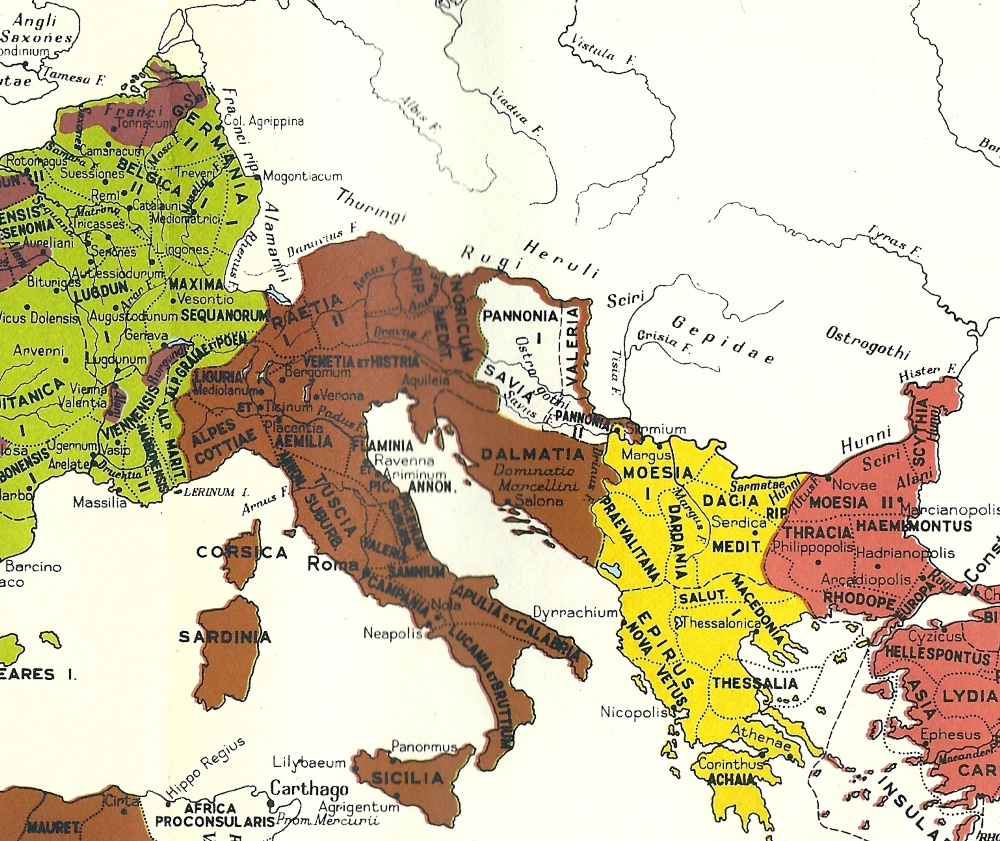
Imperium Romanum Anno 454 The Sarmatians are drawn in Dacia and the Alans partly in Scythia partly in Moesia II. |
*
Sarmatians as foederati, gentiles, and comitesThe Sarmatians, at least the members of their dominant tribes have always been mercenaries. From the 1st century B.C. to the 6th century A.C.. They served in various ranks in the Roman legions in both the Western and the Eastern Roman Empire. It are mainly the Iazyges (29), and the Alans. They are Gentiles as they serve as soldiers in the legions. They form small foreign military colonies in the army. As foederati, they were allies who served in tribal groups. This gave privileges such as obtaining land after a twenty-year service contract and for the officers after their services they are often offered the Roman citizenship. As Comes, generals, they served in the highest commanding ranks in the immediate vicinity of the emperor on his campaigns. These were mostly members of the Sarmatian royal families, but sometimes an ordinary soldier who had risen through all grades reached this high post. Magister Equitum, Commander in chief of the Cavalry of the Roman Empire is the highest rank reached by a Sarmatian. This was Victor who served under the Roman Emperor Julian the Apostate, 361-363, and after the division of the Roman Empire under the Eastern Roman Emperor Valens, 364-378. Under Valens Victor was also an envoy and visited the Goths to ask about their support against enemies of the Emperor, later he was sent to the Persian king to negotate about peace. The Sarmatian Victor is described as a hesitant and cautious man. But even when he was General he fought at the forefront. In Persia he once led the attack despite an arrow wound in his shoulder and so he won. He fought against the Goths defending the capital Constantinople. It seems odd that a stranger with this character description can reach the highest rank. Probably belonged this Sarmatian to a family which members since longer times served in the army and reached high positions, but this is not known. Acts of foreigners are less often mentioned than of born Romans. Victor wore no surname. (29a) StationingAbout the stationing of Alans in the Empire is written little. The Notitia Dignitatum composed under Emperor Honorius (395-423) is the richest source. It is a brief summary without information on the timing and origin. Here are stated the praefects of Comitates Alaniani and Sarmati. Comitates were troops that after the army reform of Emperor Diocletian (284-305) accompanied the emperor under their own leader, a comes or magister Equitum. After their service they got land and their leaders also Roman citizenship. In return, they committed themselves to an, often hereditary, military service. (30) |

|
The Notitia mentions twenty-four praefects of Sarmatians, of which seventeen in Italy, six in Gaul. At Velay was a praefect of Sarmatians and Alans and at Poitiers of Sarmatians and Taifals. The list of praefects in Germania secunda is incomplete surrendered, The nowadays Dutch region is missing. In England there was a prefect at Ribchester (Lancashire). The emblem of the Sarmatians and Taifali. |
|
This Taigal logo is very old and is already seen in 1000 b.c. on pottery of the Tocharians in the Tarim Basin, the current Chinese province of Sinkiang. In this regio lived the early Alans. The war cry or battle cry of the Sarmatians was Marha Marha. In the year 355 a Sarmation soldier in anger threw under the proclamation of this cry his his boot in the face of Emperor Constantius when these was giving a speech in Pannonia to unsatisfied Sarmatian warriors. The emperor said later that he no longer knew whether he was a commander of an ordinary foot soldier. He thought his last hour had beaten. He had to fled and no guard could prevent that the imperial seat with cushion and gold stitching was captured. Afterwards there was only a small punitive expedition because the emperor had to return urgently to Sirmium. (31) Sarmatians wore in the Roman army, their own weapons. They were good armourers. The Caucasus, where the Alans, a tribe related to the Sarmatians, traditionally lived, is one of the first regions in the world where the metallurgy developed by the Kalybers. It is possible that they have introduced at least contributed to it in Europe |
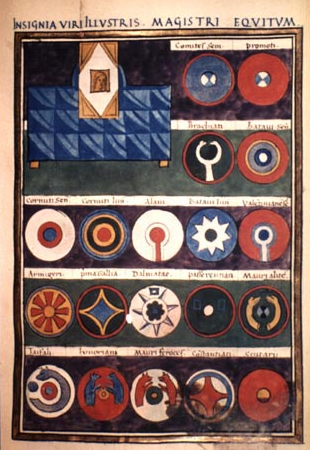
The army signs of alien equestrians.
|
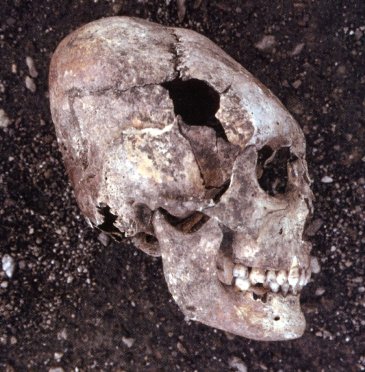
In youth deformed Gothic skull, 4th century, Globasnitz (Austria) (33) |
Emperor Maiorinus 457-461 used Alanian and Sarmatian troops in battles against the Vandals in Africa and after the defeat they were disembarked in Gaul, where they will have been be recruited. They went looting presumably because of failure of payment and invaded thereafter for some time in northern Italy under King Beorgor. In the Hungarian plain remained some Sarmatians after the Huns had gone. In the year 470 was their last known raid under their leader Babai when they again crossed the Danube and invaded Pannonia Secunda and conquered Singidunum (Belgrade). The Eastern Roman emperor Leo I sent Theodoric a later Western Roman Emperor, to the Huns and he expelled them and killed Babai. In 568 followed some of the last Sarmatians of the Danube the Lombards and participated in the conquest of Italy and settled there in several colonies in the Po Valley. |
|
The necropolis of Obernai (Alsace, Bas Rhin, France) is one of the few important groups discovered in France and it demonstrates for the first time the treatment of an Eastern community in Alsace at the end of the Roman Empire. These Merovingian necropolis consists of eighteen burials oriented west/east. Three contained silver earrings. One contained two small gold pins on the chest of the deceased, which may have fastened a garment such as a veil. A chatelaine was connected to a belt with various objects attached including a silver mirror, similar to those used by the Alano-Sarmatian populations of the Caucasus, a tweezer set and several large coloured glass beads and amber. This female also had a triangular antler comb, decorated with geometric motifs and horse heads at either end. |
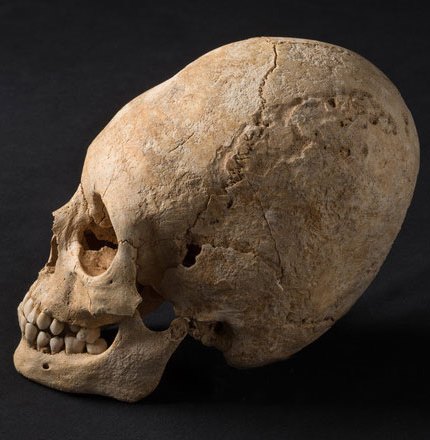
Distorted skull, necropolis in Obernai, Bas-Rhin. (33b) |
|
Besides the grave goods, the eastern origin of the individuals is attested by the presence of an intentionally deformed skull. Burials such as this have been discovered in isolation in northern Gaul, Germany and Eastern Europe and often include rich furnishings. They would appear to represent the graves of dignitaries and their families who were incorporated in to the Roman army at the time of the great migration. * The Eastern Migration of the Sauromatians |

|
After the War of the eight Princes, 291 - 306, that severely damaged the Chinese heartlands in the lower Yellow River, the people suffered for centuries from civil strife and barbarian invasions and lived in extreme poverty until Emperor Wen of the Sui Dynasty unified China in the year 589. The continual strife had created a melting pot and laid the foundation for the subsequent Sui and Tang Dynasties. Among the many ranks of barbarians that migrated into China, were the Sauromatians. who had left their homeland Sarmatia in modern-day Ukraine. During the mid 4th century they reached Siberia and Mongolia and went further toward the south. They were approximately half-a-million in number. Them was offered in the year 429 a homeland on the steppes of Inner Mongolia. Terracotta figurine of a warrior. Northern Wei. Sankokau Museum, Nara, Japan. |
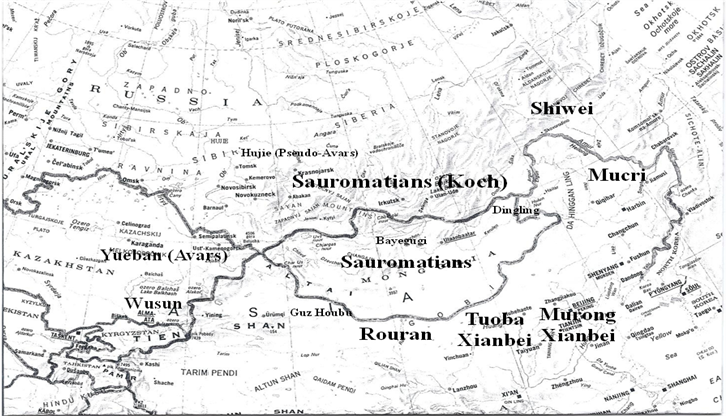
Map of Sauromatians |
|
In the year 487 the Sauros migrated to northern Xinjiang where they established an empire that the Chinese designated Koch. By 525 because of their loyalty, bravery, wild disposition, and skilled martial arts, a number of Sauro emerged, as founding fathers while other became high-ranking officers of the Eastern and Western Wei Dynasties. They integrated into the Chinese Han culture, took Chinese surnames, and intermarried with the Chinese. In 551 The Tu-Jue ambushed and conquered them in Xinjiang Province. Their Empire was decimated. In 630 the remaining were resettled and after repeated rebellions 50,000 of them were thereafter again resettled in the southern Henan Province. |
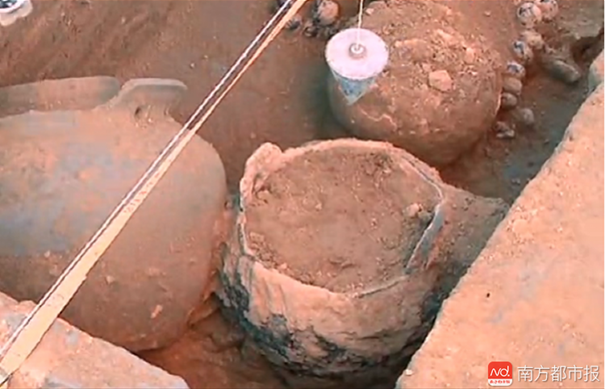
Bronze cauldron found in tombs of Anyang Yin Ruins in Anyang, Henan. These tombs may be of the Huns or the Samatians, dated 1800 ybp. |
|
Today the descendants of the Sauro know little of their ancestry. Since the mid-19th century, Russian and Chinese archaeologists have excavated an enormous quantity of burials and their artifacts in Siberia, Trans-Baikal, Mongolia, Inner Mongolia, Manchuria, and Xinjiang. These have been stylistically identified as Scytho-Sarmatian. The biggest impact the Sauromatians introduced to the Han Chinese was, Scytho-Sauromatian portable art and a number of outstanding Chineselized political and military leaders. These people of Sauromatian descent were among the important founding monarchs of Sui and Tang dynasties and under their leadership an age of prosperity ruled over China.
Because the royal families of the Sui and Tang Dynasties had barbarian blood, China was able to establish a civil examination system to replace the system of selection from powerful families. Since then, this examination system has changed all the classes of the society for over a thousand years. It was truly a turning point for the social classes in China. (33c) See for this: Chang, Hua'an, 常華安. 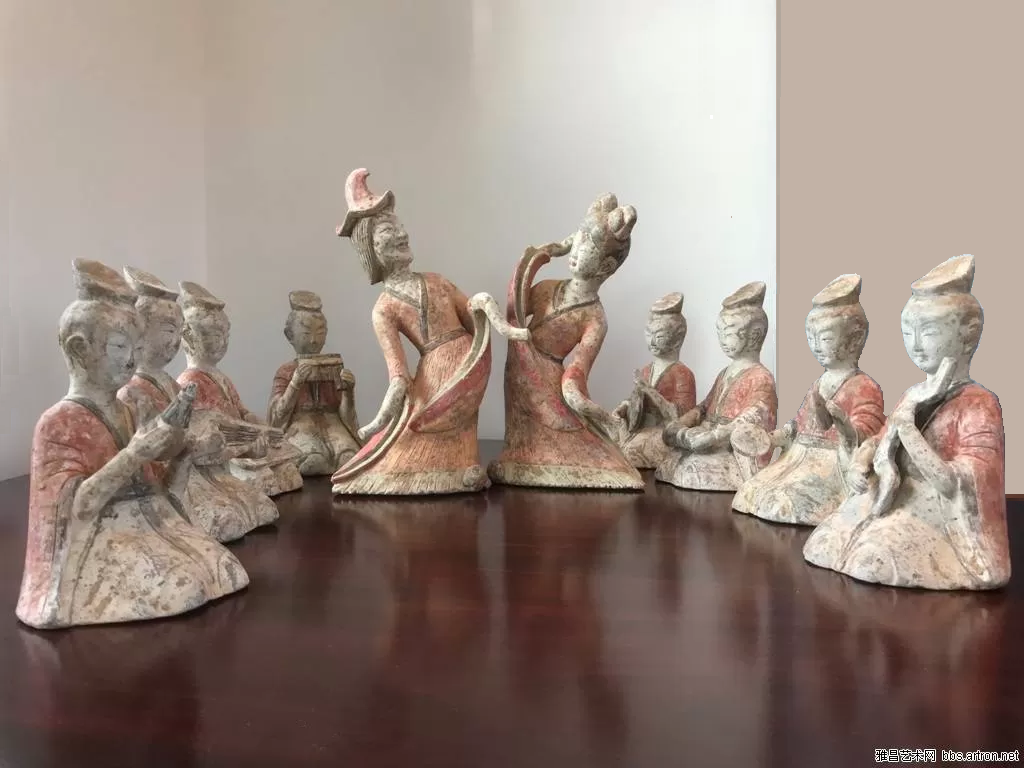
Hsien Bei Band with Sauromatian dancers * Sarmatians and Alans on the Northern Border at TungriIn the Notitia Dignitatum, a description of all civil and military authorities of the Roman Empire around 430, we find a description of our regions. Here is the Praefectus Laetorum Lagentium prope Tungros stated. This praefect was probably in the old civic center Atuatuca, but also perhaps in the a fortresses on the Maas Transition, Mosae Traiectum, Maastricht. This was already an important trading center at the junction of two important trade routes, the military road from Cologne to Boulogne sur Mer and the river Maas. The map below shows the northern borders of the Empire, the late Roman defense system. We see many castles. The horse heads show the stationing of the allied troops, most Germans. The northernmost praefect lays at Tongeren and Famars, both at that road. In Famars (Fanum Martis) the Sarmatians were established. (33d) The Alanianian king Goar who in 406 had came to Gaul on his own initiative, joined there with his men the Roman army. Five years later he proclaimed together with a Burgundian king the Roman patrician Iovinus to emperor. This held only two years. In 413 the newly elected emperor was defeated by another candidate and was executed. Hereafter followed actions against foreigners. Perhaps was the removal in 413 of the Sarmatians from (Castra Vetera) current Xanten to Fanum Martis, the current Famars, s a consequence of this. When the Roman Empire by the end of this century imploded and the army retreated to Italy these alien soldiers and their families were settled in Belgica secunda in exchange for their hereditary military conscription. Many cities in France and also many places elsewhere in Europe especially in Italy bare names like Sampigny, Sermaise, Sermoise, Sermiers, Sarmato and also Alaincourt, Alland'Huy, Aillainville. They are obviously settlements of Sarnatians (and Alans). 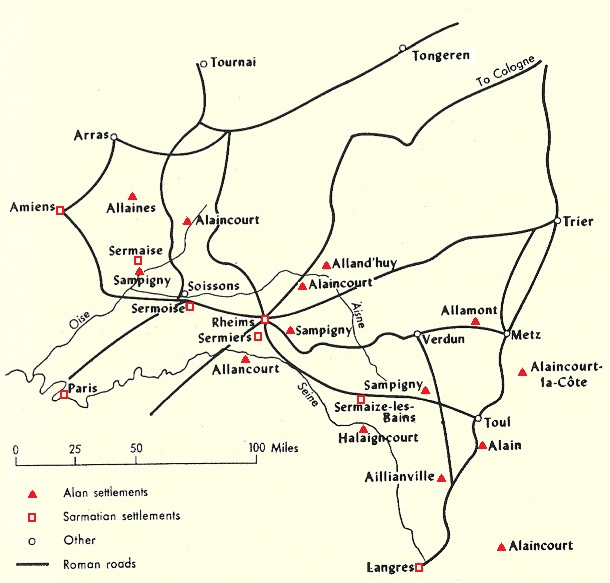
Samatic and Alanianian locations in North-East Gallia. (34a) In England are in contrast to Europe archaeological remains found. The best known is the tomb in Chester (35). But although in Europe there are some graves for instance in Wallis (Sw.) dating from the 5th century, and at Valence (Fr.) 4th century, where are skulls found that have the same deformation as seen at the steppe peoples in the Ukraine, where the Sarmatians had these same characteristic skull deformation, caused by tight bandage of the skull of growing babies. (36) |
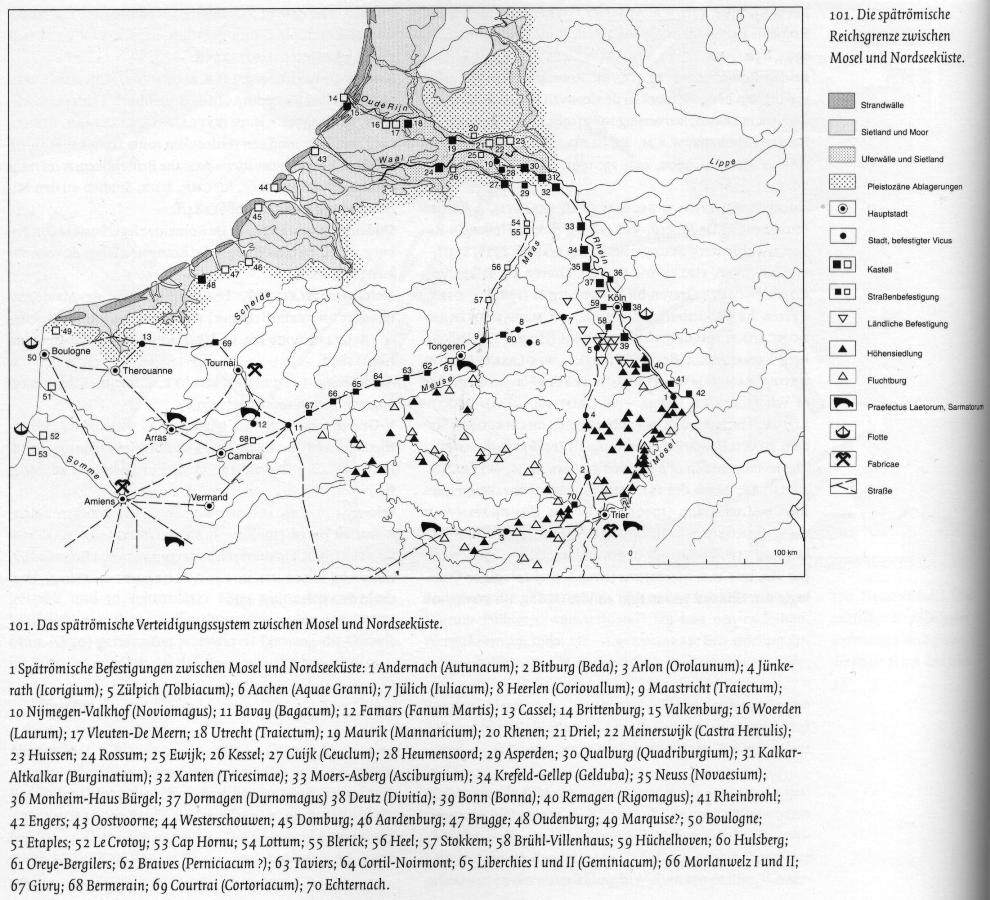
Tilmann Bechert and Willem J.H.Willems, The Roman fortifications on the northern border from the Moselle to the North Sea.
|
|
* DNASarmatians served in the Roman legions. Veterans settled in Italy, Gallia and on the Northern borders of the Empire in England, Belgiun, Germany, Austria. Perhaps there their DNA will be found there in the population or in archaeological remains. It must be considered that before the beginning of our era they lived in South Russia and consisted of many tribes. Conquered peoples were often admitted into their midst and they were related to the Alans. See: Alan and Sarmatian DNA* To write this article, a number of recent and classic works were studied. (39) |
|
|
|||